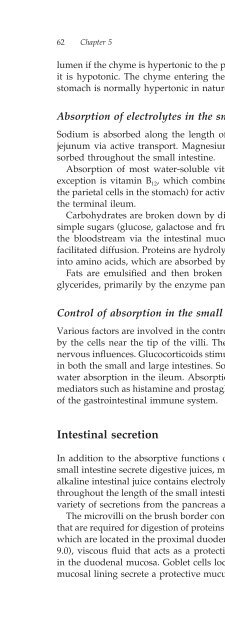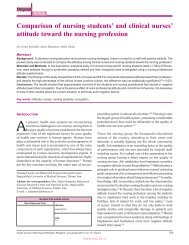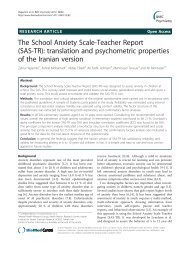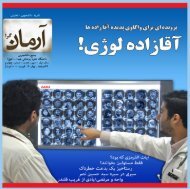Gastrointestinal Nursing.pdf
Gastrointestinal Nursing.pdf
Gastrointestinal Nursing.pdf
Create successful ePaper yourself
Turn your PDF publications into a flip-book with our unique Google optimized e-Paper software.
62 Chapter 5lumen if the chyme is hypertonic to the plasma, and absorbed into the blood ifit is hypotonic. The chyme entering the duodenum from the pylorus of thestomach is normally hypertonic in nature.Absorption of electrolytes in the small intestineSodium is absorbed along the length of the small bowel but mainly in thejejunum via active transport. Magnesium, phosphate and potassium are absorbedthroughout the small intestine.Absorption of most water-soluble vitamins takes place by diffusion. Theexception is vitamin B 12 , which combines with intrinsic factor (produced bythe parietal cells in the stomach) for active transport and is mainly absorbed inthe terminal ileum.Carbohydrates are broken down by digestive enzymes in the intestine intosimple sugars (glucose, galactose and fructose), which are then absorbed intothe bloodstream via the intestinal mucosa, using either active transport orfacilitated diffusion. Proteins are hydrolysed by proteolytic digestive enzymesinto amino acids, which are absorbed by active transport.Fats are emulsified and then broken down into glycerol, fatty acids andglycerides, primarily by the enzyme pancreatic lipase.Control of absorption in the small intestineVarious factors are involved in the control of water and electrolyte absorptionby the cells near the tip of the villi. These include endocrine, paracrine andnervous influences. Glucocorticoids stimulate electrolyte and water absorptionin both the small and large intestines. Somatostatin stimulates electrolyte andwater absorption in the ileum. Absorption can be inhibited by inflammatorymediators such as histamine and prostaglandins, which are released from cellsof the gastrointestinal immune system.Intestinal secretionIn addition to the absorptive functions of the small intestine, the cells of thesmall intestine secrete digestive juices, mucus and a variety of hormones. Thisalkaline intestinal juice contains electrolytes, mucus and water and is secretedthroughout the length of the small intestine. The small intestine also receives avariety of secretions from the pancreas and the liver.The microvilli on the brush border contain the peptidases and disaccharidesthat are required for digestion of proteins and carbohydrates. Brunner’s glands,which are located in the proximal duodenum, secrete a clear, alkaline (pH 8.2–9.0), viscous fluid that acts as a protective layer from gastric acid secretionsin the duodenal mucosa. Goblet cells located on and between the villi on themucosal lining secrete a protective mucus.















